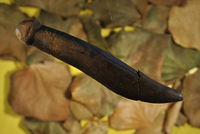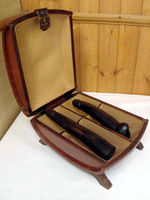Dildo: Różnice pomiędzy wersjami
Nie podano opisu zmian |
Nie podano opisu zmian |
||
| Linia 1: | Linia 1: | ||
{{zalążek artykułu}} | |||
From Philip S. Rawson’s Primitive Erotic Art: “”In Europe through medieval times, even into the eighteenth century, it was customary for dildos (called ‘love gods’ or ‘love birds’), which were roughly shaped as phallic-headed birds, to be sold openly in markets.”<ref>http://jessnevins.com/blog/?p=4</ref> | From Philip S. Rawson’s Primitive Erotic Art: “”In Europe through medieval times, even into the eighteenth century, it was customary for dildos (called ‘love gods’ or ‘love birds’), which were roughly shaped as phallic-headed birds, to be sold openly in markets.”<ref>http://jessnevins.com/blog/?p=4</ref> | ||
| Linia 56: | Linia 58: | ||
== Bibliografia == | == Bibliografia == | ||
<references/> | <references/> | ||
[[Kategoria:Higiena]] | |||
[[Kategoria:Seks]] | |||
Wersja z 16:15, 22 cze 2012
|
To jest tylko zalążek artykułu. Jeśli posiadasz wystarczającą wiedzę i materiały źródłowe, pomóż go nam rozwinąć! |
From Philip S. Rawson’s Primitive Erotic Art: “”In Europe through medieval times, even into the eighteenth century, it was customary for dildos (called ‘love gods’ or ‘love birds’), which were roughly shaped as phallic-headed birds, to be sold openly in markets.”[1]
From Claude J. Summers’ The Queer Encyclopedia of the Visual Arts, “The English word “dildo” is first recorded around 1592, in a poem by John Nashe. John Donne in his licentious elegies also refers to dildos. In the eighteenth century, Fuseli drew a woman wearing one.”[2]
There are some references to the use of dildos by women in the Middle Ages, in particular, this one in a Church “penitential,” a book that prescribes punishments for sins.
“Have you done what certain women are accustomed to do, that is to make some sort of device or implement in the shape of the male member of a size to match your sinful desire? If you have done this, you shall do penance for five years on legitimate holy days.”[3]
The word dildo was not actually used until the Renaissance period, according to the Oxford English Dictionary, but one fanciful explanation of its origin was a small elongated loaf of bread flavored with dill, thus “dilldough.”
One writer in the renaissance period referred to the popularity of dildos imported from Italy:[4]
You ladies all of merry England Who have been to kiss the Duchess' hand, Pray, did you not lately observe in the show A noble Italian called Signor Dildo? ...
A rabble of pricks who were welcomed before, Now finding the porter denied them the door, Maliciously waited his coming below And inhumanly fell on Signor Dildo ...
Historia wibratora w skrócie
A Brief History of Hysteria (and Vibrators) [5]
- 4th Century BCE: The idea that a “wandering uterus” (literally, hysteria) can cause strange symptoms, from amnesia to sleepwalking to madness, is first mentioned by the Ancient Greeks in the Hippocratic Corpus. Women’s sexual organs will be tied to unexplained behavior for the next 4,000 years.
- 2nd Century A.D.: The early Greek physician Galen concludes that hysteria’s cause is sexual deprivation. The treatment he recommends is marriage. He is also the first to suggest the remedy of “digital manipulation,” describing the success of a woman he treated in this way: “From that time on, she was free of all the evils she felt.”
- 2nd Century A.D.: The Roman philosopher Celsus first recommends bloodletting as a possible cure for women’s hysteria.
- 10th Century: The Persian physician and prolific medical writer Avicenna recommends a “rubbing” cure for hysteria, which he says will allow troubled women to “find peace.”
- 13th Century: The Spanish alchemist Arnaldus de Villanova recommends the use of vaginal suppositories to adjust the “balance of humors” in women with intractable disorders of various kinds.
- 16th Century: The French physician Phare writes of a new cure for hysteria: sending women to ride through the woods on horseback.
- 1653: The renowned Dutch doctor Pieter van Foreest writes about his treatment for hysteria -- involving pelvic massage “to paroxysm.” He especially advises it for “widows, those who live chaste lives, and female religious.”
- 17th Century: The pioneering English physician William Harvey, the first to describe the human circulatory system, opines that the female sexual organs are the cause of “horrid extravagancies of minde . . . Phrensies, Melancholy, Distempers and Outrageousness.”
- 18th Century: “Hydrotherapy devices,” often involving well-aimed nozzles, come into vogue as a therapy for a vast variety of female disorders at European health spas.
- 18th and 19th Centuries: The term “Hysterick Fits” becomes popular in medical circles, used to describe a wide range of poorly understood phenomena, from epilepsy, depression and Tourette’s Syndrome to rebelliousness, marital displeasure and sexual infidelity.
- 1850s: Leading French physician Pierre Briquet announces the results of his study of female hysteria: it is caused by sexual frustration and the cure lies in the perfectly medical treatment he names as “la titillation du clitoris.”
- 1859: A study among British physicians finds that up to 40% of the female populace has now been diagnosed with hysteria.
- 1866: English doctor Isaac Baker-Brown offers an alternative to massage treatment for female hysterics -- clitoridectomy – before being banned from the London Obstetrical Society after an untold number of such surgeries.
- 1869: The American inventor George Taylor comes up with a steam-powered massage machine known as “The Manipulator.” Physicians treating hysteria quickly adopt it, but Taylor urges caution when using it on female patients in order to prevent overindulgence.
- 1883: The first electric vibrator is patented by Joseph Mortimer Granville and, despite his desire that it be used for muscular relief, is soon offered as a treatment for hysteria.
- 1895: Sigmund Freud and his associate Joseph Breuer write their landmark book on hysteria, and conclude something new: it is a mental rather than physical disorder, stemming from traumatic sexual experiences in early childhood. In the process, they kick-start the modern era of psychoanalysis.
- 1899: The Vibratile, a simple, $5 vibrator made out of wire, is advertised in McClure’s Magazine, a popular 19th Century monthly, promising a cure for neuralgia, headaches and wrinkles.
- Early 1900s: Dozens of “portable relaxation devices” are now being advertised in a variety of ladies’ magazines.
- 1908: The London Times publishes an editorial that says some suffragettes rallying for the right to vote “are suffering from hysteria.” This idea spreads, with anti-suffragette leaders questioning the mental health of female activists.
- 1918: Vibrating massagers are offered in the Sears Roebuck Catalog, advertised as “very useful and satisfactory for home service.”
- 1952: The American Psychiatric Institute finally determines that hysteria is not a disease.
- 1970s: The vibrator comes out of the closet, celebrated by feminists as a tool for sexual liberation.
- 2007: The Supreme Court refuses to hear a case questioning the constitutionality of state laws that prohibit the sexual use of vibrators in several states, making them still illegal for sexual purposes in Alabama, Georgia, Indiana, Louisiana, Massachusetts, Mississippi, Texas, and Virginia.
Galeria
- Fallusy
Dildo znalezione w klasztorze, (XVIII wiek)
Drewniane dildo w szkatule wyłożonej skórą, (XVIII wiek)
Bibliografia
- ↑ http://jessnevins.com/blog/?p=4
- ↑ http://jessnevins.com/blog/?p=4
- ↑ http://www.oddee.com/item_96646.aspx
- ↑ http://www.oddee.com/item_96646.aspx
- ↑ "HYSTERIA", NZ Marketing & Publicity enquiries: Adria Buckton, Trigger Marketing & Publicity, New Zealand Release Date: TBC August 2012


